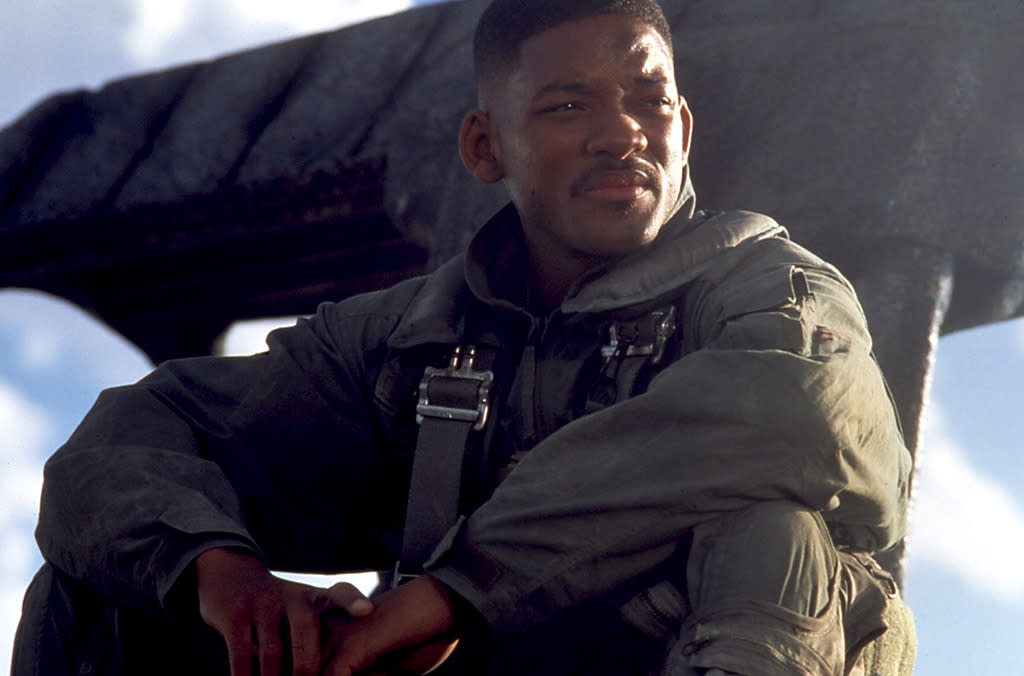‘Independence Day’ Helped Make Will Smith a Superstar

Will Smith in Independence Day. (Everett)
Will Smith’s rise from a novelty hip-hop act to lanky 1990s sitcom star was a relatively natural one. The musician turned actor’s personas on his and DJ Jazzy Jeff’s 1988 sophomore LP, He’s the DJ, I’m the Rapper, and NBC’s The Fresh Prince of Bel-Air were basically identical: His small-screen work was merely an extension of the funny, clever output he’d been crafting in the recording booth. Neither project portended a wider career as a Hollywood heavyweight. Yet when Independence Day opened on July 2, 1996, Smith was almost instantly set on a path toward becoming the World’s Biggest Movie Star — a transformation that was as stunning as it was swift.
Few saw this development coming. The Fresh Prince of Bel-Air was just finishing its seven-year TV run, and ID4 was only the fifth feature in which Smith had starred. Of his previous four big-screen outings, the one that had made the most noise was 1993’s Six Degrees of Separation, an adaptation of John Guare’s Pulitzer Prize–winning 1990 play about a young con man (played by Smith) who convinces a wealthy New York City family that he’s the son of Sidney Poitier. That role was notable because it was opposite Stockard Channing, who received an Academy Award nomination for the film. It didn’t, however, garner him particularly favorable critical notices (The New York Times’ Janet Maslin wrote, “The film’s only casting misstep comes with Mr. Smith, who plays Paul as a smooth, pleasant interloper without the hints of mockery or desperation that should accompany his deception.”)
Watch the original ‘Independence Day’ trailer:
His follow-up was 1995’s Bad Boys, a flashy, violent action vehicle that paired him with motormouth comedian Martin Lawrence. In hindsight, the sizable success of 2003’s Bad Boys II has cast the original in a more positive light. It debuted to only modest box-office numbers (it opened at No. 1 on April 7, 1995, with $15.5 million, on the way to a $65.8 million domestic haul) and was generally shrugged off by critics, who praised the leads’ chemistry while largely dismissing the film on the whole as a sleek, explosion-heavy exercise from up-and-coming director Michael Bay. While its reputation would grow in subsequent years thanks to Smith’s and Bay’s A-list ascendency, it initially seemed like something of an awkward fit for the actor, whose comedic presence didn’t quite mesh with the material’s outsize mayhem.
Related: How 1996’s ‘Independence Day’ Ignited the Movie Trend of Destroying Our Favorite Tourist Spots
Independence Day, however, immediately and irrevocably changed that perception. An enormous 20th Century Fox production spearheaded by Roland Emmerich — who was coming off 1994’s Stargate — the sci-fi film was designed as an ensemble piece. While Smith was cast as the story’s nominal lead, ace fighter pilot Steven Hiller, he was merely one cog in a gargantuan machine, nominally no more important or high-profile a figure than Bill Pullman’s president (who gets the most famous speech), Jeff Goldblum’s computer expert, or even Randy Quaid’s crop-dusting alcoholic.
Nonetheless, Steven Hiller quickly became the defining role of Smith’s early career, less because of its nuance or depth than because it finally gave his megawatt charm the enormous canvas it demanded. Emmerich reportedly hired Smith based on his Six Degrees of Separation work, but that prior, understated turn is light years removed from his performance in Independence Day. Newly buff, Smith exhibited an everyman-but-BIGGER appeal from the moment his Hiller — decked out in a tank top — looks up from his morning paper to gaze upon an alien UFO.
With his subsequent bevy of one-liners, he’d seamlessly marry his expert comedic timing with his newfound physical stature. He was, all of a sudden, a larger-than-life figure with imposing charisma and sex appeal to spare. As Lisa Schwarzbaum wrote in her Entertainment Weekly review of the film, “Smith is so deft, so unburdened by everything that’s riding on him, that he lofts us to giddiness. Blam, he slugs a particularly intrepid alien who has hit the Arizona sand. “Welcome to Earth,” he snips. Wooohoooo! goes the audience.”
ID4 would go on to become the biggest release of 1996 (and, at the time, the second-highest-grossing film ever, with a $817.4 global tally). And Smith would capitalize on his newfound superstardom by again going to the sci-fi well with 1997’s Men in Black, another E.T.-centric affair that would put his cocky yet self-deprecating swagger to pitch-perfect use. It was a smash hit that teamed him with straight man Tommy Lee Jones and confirmed that Smith was a Hollywood force to be reckoned with.
His third stab at July Fourth weekend dominance would fall flat with 1999’s Wild Wild West, and he’d soon start seeking out increasingly varied material, including daring projects like Michael Mann’s 2001 Muhammad Ali biopic Ali, 2005’s romantic comedy Hitch, and 2006’s The Pursuit of Happyness. However, as would be clear from his repeated return to sci-fi fantasy efforts (Men in Black II, I, Robot, I Am Legend, Hancock, After Earth), Smith has never been more at home than when he’s joking around while battling otherworldly threats — a fact first proved by the film that forever altered his career.
Meet Jessie T. Usher, the new star of ‘Independence Day: Resurgence:’
